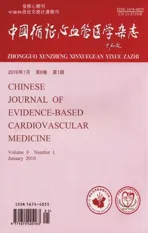心室重构药物防治的新进展
2016-01-24马守国卢才义
马守国,卢才义
心室重构药物防治的新进展
马守国1,卢才义2
目前认为心室重构是心力衰竭(心衰)发生发展的最主要机制,有效控制心室重构的发生发展,是减少心脏病患者心衰发生率和死亡率的重要环节。如何延缓和逆转心室重构是心衰研究领域的热点,也是防治心衰的难点。从药物的应用、干细胞移植、辅助装置、生物制剂到基因修饰等,都曾用于心室重构的防治,并取得了一定的成就。现就近年来心室重构药物防治方面的新进展作一综述。
1 肾素-血管紧张素-醛固酮系统(RAAS)抑制剂
血管紧张素转化酶抑制剂(ACEI)、血管紧张素Ⅱ受体拮抗剂(ARB)及醛固酮受体拮抗剂(MRA)是RAAS不同环节的阻滞剂,可有效控制血压、减少心衰患者发病率及死亡率。β-肾上腺素受体阻滞剂,ACEI,ARB和MRA目前作为治疗左心功能不全心衰患者的指南用药[1,2]。研究表明,降压药物ACEI和ARB能够减轻心肌肥厚及抗细胞外基质增生,还能减轻心肌梗死后心室重构。其作用机制为:减轻心脏的前、后负荷,抑制血管紧张素Ⅱ(Ang Ⅱ)的产生和直接阻断其受体,抑制心肌细胞肥大,减少细胞外基质的增生和间质纤维化,改善血管内皮细胞的结构和功能等,延缓和逆转心室重构。目前常用的ARB为1型AngⅡ受体拮抗剂,2型受体在正常成人表达很低,但在心衰时明显增加。在某些情况下,激活1型和2型受体作用相反,激活2型受体舒张血管和抑制心肌肥厚。新药2型血管紧张素Ⅱ受体激动剂复合物21,在啮齿类动物试验中有减少心肌梗死面积的疗效[3,4]。
阿利吉仑是新一代非肽类肾素抑制剂,通过抑制肾素分泌,减少Ang Ⅱ和醛固酮的分泌,起到降压和治疗心血管疾病的作用。近年来在ALOFT试验和ASPITE试验中观察到阿利吉仑有改善梗死后心室重构和抗心衰的作用[5,6]。在ASTRONAUT试验中,阿利吉仑在急性心衰患者中的疗效与ACEI相近[7]。阿利吉仑与依那普利在心衰患者的疗效对比试验中,阿利吉仑抗心室重构的潜在价值值得期待[8]。醛固酮是肾上腺皮质分泌的盐皮质激素,可阻断NO合酶活性、促进心肌炎症和纤维化以及凋亡等。低剂量的醛固酮受体拮抗剂有抗心衰、抑制心室重构和降低心衰患者死亡率的作用,依普利酮可显著减少心衰患者死亡率和再住院率[9]。而安体舒通因代谢、内分泌副作用及其它不良反应,临床应用受限,且TOPCAT研究显示其对左心功能保留患者的心衰并无益处[10]。慢性心衰患者由于醛固酮合成酶活性的增加,可引起非盐皮质激素受体介导的反应,如氧化应激等。而醛固酮受体拮抗剂对盐皮质激素受体的阻断,增加了血浆醛固酮合成酶活性,醛固酮水平升高。醛固酮合成酶抑制剂FAD286可通过抑制醛固酮合成最后一步所需催化酶,减少醛固酮的合成,从而可减轻大鼠心衰的左心室重构[11]。
血管紧张素受体-脑啡肽酶抑制剂(ARNI)LCZ696由血管紧张素Ⅱ受体拮抗剂缬沙坦和脑啡肽酶抑制剂sacubitril两部分组成,其Ⅲ期临床试验(PARADIGM-HF试验)显示,LCZ696与经典ACEI药物依那普利对比,慢性心衰患者住院率、心源性死亡率降低了21%。研究纳入了8442例心功能分级Ⅱ~Ⅳ级且左室射血分数低于40%的心衰患者,LCZ686和依那普利干预后,随访27个月,两组心源性死亡或因心衰住院发生率均降低,提示LCZ686疗效与安全性较好[12]。
2 β-肾上腺素受体阻滞剂(β-ARB)
β-肾上腺素受体阻滞剂除了应用于降压抗心律失常外,已广泛应用于心衰的治疗,实验和临床研究都证实β-ARB可减少心肌的负性重构和增加心衰患者的生存率[13],其机制为阻断交感神经系统、RAAS系统,改善心脏功能,减慢心率,减少心肌氧耗,改善心肌氧供需平衡,延缓和逆转心室重构。G蛋白偶联受体激酶(GRKs)是与G蛋白偶联受体(GPCRs)快速失活相关的激酶,心肌内的GRKs主要为GRK2、GRK3、GRK4、GRK5等,又称为β肾上腺受体激酶(β-ARK)。持续刺激心肌β-肾上腺素受体,会导致GRK2、GRK5磷酸化β-肾上腺素受体,造成其失活,最终导致心输出量减少。心衰时GRK2和GRK5表达和活性均增高,加重心衰。因此,GRK2、GRK5的靶向抑制可能是挽救心衰的潜在治疗途径[14-16]。
3 3羟基-3甲基-戊二酰辅酶 A(HMG-CoA)抑制剂(他汀类药物)
调脂药物在缺血性心脏疾病患者中广泛应用,降低血脂,还可抑制和逆转心室重构。近年来的研究发现,他汀类药物能够抗心肌纤维化,抗氧化,抑制炎症细胞因子,降低交感神经活性及改善血管内皮功能等,从而改善心功能,抑制和逆转心室重构。但有些临床试验结果显示,他汀类药物对抗心衰无明显作用[17,18]。
4 正性肌力药物
正性肌力药物用于失代偿性心衰和终末期心衰患者,改善临床症状。常用的正性肌力药物有洋地黄类和非洋地黄类。虽然长期应用地高辛对死亡率无明显影响,但长期应用正性肌力药物能够增加患者死亡风险。左西孟旦为新型正性肌力药物,是钙增敏剂的一种,通过与心肌细肌丝上的肌钙蛋白C氨基末端结合,增加肌钙蛋白C和Ca2+复合物的构象稳定性。增加心肌收缩力,而对心肌的舒张功能影响较小。Istaroxime通过抑制钠钾ATP酶和激活肌浆网Ca2+ATP酶,提高心肌收缩力和加速心肌舒张,具有增加心肌收缩和舒张功能的双向调节作用。大量的动物实验及前期临床试验已经证实,Istaroxime治疗心衰安全有效,且不影响收缩压和心率,不增加心肌氧耗,未诱发致命性心律失常[19,20]。Istaroxime抗心衰的应用前景非常广阔。心肌肌球蛋白激活剂Omecamtiv mecarbil(CK-1827452)可以延长左心室收缩持续时间,增加每搏输出量,而不影响Ca2+通道的稳定性和增加心肌氧耗。有研究表明[21],CK-1827452在缺血性心肌病、心绞痛患者治疗中较安全。
5 血管内皮素-1(ET-1)受体拮抗剂
内皮素是由血管内皮、心肌、平滑肌细胞等合成分泌的21个氨基酸的多肽,有三个异构体,其中ET-1具有强烈而持久的收缩血管作用,同时促进细胞有丝分裂和增殖,是引起肺动脉高压、心衰等多种疾病的炎症因子。目前已经上市的内皮素受体拮抗剂有波生坦、恩拉生坦、替唑生坦、西他生坦、阿曲生坦及安倍生坦等。替唑生坦与安慰剂比较,能明显改善急性心衰患者的血液动力学[22,23]。其在改善心室重构及抗心衰治疗中的作用尚需进一步研究。
6 胰高血糖素样肽-1(GLP-1)
GLP-1是由小肠合成并分泌的肠降血糖素,有促进胰岛素分泌等作用,用于2型糖尿病的治疗。胰岛素抵抗和脂毒性是扩张型心肌病和代谢性心肌病的特点,也即是心衰患者有明显的代谢异常[24,25]。GLP-1通过P38-丝裂原活化蛋白激酶途径刺激扩张型心肌病患者的心肌对葡萄糖的摄取,以增加心衰大鼠左室的收缩功能和延长生存时间[26]。
7 新的血管扩张药
磷酸二酯酶V(PDE5)选择性抑制剂西地那非,通过释放生物活性物质NO舒张血管平滑肌。有研究表明[27],西地那非改善左室功能保留心衰患者血液动力学,提高左室舒张功能和右室收缩功能。RELAX试验中,射血分数保留的心衰患者,24周西地那非治疗后,运动耐力和临床特征均未有显著改善[28]。血管内皮细胞合成的一氧化氮(NO),有抑制心肌肥厚,抗细胞凋亡,抗纤维化作用,从而改善心室重构[29]。增加内皮细胞NO合成酶活性药物AVE9488,有改善心室重构的作用,包括抑制心肌肥厚,抑制纤维化和心室扩张,增加心肌收缩力,而并未增加心肌重量[30]。
总之,近年来对心室重构的病理生理机制的认识逐渐深入,促进了抗心室重构药物的研发。尤其是ACEI、ARB、醛固酮受体拮抗剂及β-受体阻滞剂已经成为改善心室重构的标准药物。随着对心室负性重构机制的进一步了解,可以逆转和改善心室重构的药物逐渐或已经开始临床应用。血管紧张素受体-脑啡肽酶抑制剂、新型的钙增敏剂、内皮素受体拮抗剂、胰高血糖素样肽-1、NO合成酶激活剂等,是潜在的可以有效改善心室重构的新药。
[1] Hunt SA,Abraham WT,Chin MH,et al. 2009 Focused update incorporated into the ACC/AHA 2005 guidelines for the diagnosis and management of heart failure in adults: a report of the American College of Cardiology Foundation/American Heart Association Task Force on Practice Guidelines: developed in collaboration with the International Society for Heart and Lung Transplantation[J]. Circulation,2009,119(14):e391-e479.
[2] Xie M,Burchfield JS,Hill JA. Pathological ventricular remodeling: therapies: part 2 of 2[J]. Circulation,2013,128(9):1021-30.
[3] Unger T,Paulis L,Sica DA. Therapeutic perspectives in hypertension: novel means for renin-angiotensin-aldosterone system modulation and emerging device-based approaches[J]. Eur Heart J,2011,32(22):2739-47.
[4] Unger T,Dahlof B. Compound 21, the first orally active, selective agonist of the angiotensin type 2 receptor (AT2): implications for AT2 receptor research and therapeutic potential[J]. J Renin Angiotensin Aldosterone Syst,2010,11(1):75-7.
[5] McMurray JJ,Pitt B,Latini R,et al. Aliskiren Observation of Heart Failure Treatment(ALOFT) Investigators. Effects of the oral direct renin inhibitor aliskren in patients with symptomatic heart failure[J]. Circ Heart Fail,2008,1(1):17-24.
[6] Solomon SD,Shin SH,Shah A,et al. Effect of the direct renin inhibitor aliskiren on left ventricular remodelling following myocardial infarction with systolic dysfunction[J]. Eur Heart J,2011,32(10):1227-34.
[7] Gheorghiade M,Albaghdadi M,Zannad F,et al. Rationale and design of the multicentre, randomized, double-blind, placebo-controlled Aliskiren Trial in Acute Heart Failure Outcomes(ASTRONAUT)[J]. Eur J Heart Fail,2011,13(1):100-6.
[8] Krum H,Massie B,Abreham WT,et al. Direct renin inhibition in addition to or as an alternative to angiotensin converting enzyme inhibition in patients with chronic systolic heart failure: rationale and design of the Aliskiren Trial to Minimize Outcomes in Patients With Heart Failure(ATMOSPHERE) study[J]. Eur J HeartFail,2011,13(1):107-14.
[9] Zannad F,McMurray JJ,Krum H,et al. Eplerenone in patients with systolic heart failure and mild symptoms[J]. N Engl J Med,2011,364(1):11-21.
[10] Sica DA. Pharmacokinetics and pharmacodynamics of mineralocorticoid blocking agents and their effects on potassium honmeostasis[J]. Heart Fail Rev,2005,10(1):23-9.
[11] Mulder P,Mellin V,Faver J,et al. Aldosterone synthase inhibition improves cardiovascular function and structure in rats with heart failure: a comparison with spironolactone[J]. Eur Heart J,2008,29(17):2171-9.
[12] Gu J,Noe A,Chandra P,et al. Pharmacokinetics and pharmacodynamics of LCZ696, a novel dual-acting angiotensin receptor-neprilysin inhibitor(ARNI)[J]. J Clin Pharmacol,2010,50(4):401-14.
[13] Lechat P,Packer M,Chalon S,et al. Clinical effefcts of beta-adrenergic blockade in chronic heart failure: a meta-analysis of double-blind,placebo-controlled, randomized trails[J]. Circulation,1998,98(12): 1184-91.
[14] Reinkober J,Tschechner H,Pleger ST,et al. Targeting grk2 by gene therapy for heart failure: benefits above beta-blockade[J]. Gene Ther,2012,19(6):686-93.
[15] Williams ML,Hata JA,Schroder J,et al. Targeted beta-adrenergic receptor kinase(beta-ARK1) inhibition by gene transfer in failing human hearts[J]. Circulation,2004,109(13):1590-3.
[16] Talameh JA,Mcleod HL,Adams KF,et al. Genetic tailoring of pharmacotherapy in heart failure: optimize the old, while we wait for something new[J]. J Card Fail,2012,18(4):338-49.
[17] Kjekshus J,Apetrei E,Barrios V,et al. Rosuvastatin in older patients with systolic heart failure[J]. N Engl J Med,2007,357(22):2248-61.
[18] Tavazzi L,Maggioni AP,Marchioli R,et al. Effect of rosuvastatin in patients with chronic heart failure (the GISSI-HF trial): a randomised, double-blind, placebo-controlled trial[J]. Lancet,2008,372(9645):1231-9.
[19] Jessup M,Greenberg B,Mancini D,et al. Calcium Upregulation by Percutaneous Administration of Gene Therapy in Cardiac Diaease (CUPID): a phase 2 trial of intracoronary gene therapy of sarcoplasmic reticulum Ca2+-ATPase in patients with advanced heart failure[J]. Circulation,2011,124(3):304-13.
[20] Gheorghiade M,Blair JE,Filippatos GS,et al. Hemodynamic,echocardiographic, and neurohormonal effects of istaroxime, a novel intravenous inotropic and lusitropic agent: a randomized controlled trial in patients hospitalized with heart failure[J]. J Am Coll Cardiol,2008,51(23):2276-85.
[21] Cleland JG,Teerlink JR,Senior R,et al. The effects of the cardiac myosin activator, omecamtiv mecarbil, on cardiac function in systolic heart failure: a double-blind, placebo-controlled trial, crossover,dose-ranging phase 2 trial[J]. Lancet,2011,378(9792):676-83.
[22] Prased SK,Dargiel J,Smith GC,et al. Comparison of the dual receptor endothelin antagonist enrasentan with enalapril in asymptomatic left ventricular systolic dysfunction: a cardiovascular magnetic resonance study[J]. Heart,2006,92(6):798-803.
[23] Cotter G,Kaluski E,Stangle K,et al. The hemodynamie and neurohormonal effects of low doses of tezosentan( an endothelin A/B receptor antagonist) in patients with acute heart failure[J]. Eur J Heart Fail,2004,6(5):601-9.
[24] Fields AV,Patterson B,Karnik AA,et al. Glucagon-like peptide-1 and myocardial protection: more than glycemic control[J]. Clin Cardiol,2009,32(5):236-43.
[25] Battiprolu PK,Lopez-Crisosto C,Wang ZV,et al. Diabetic cardiomyopathy and metabolic remodeling of the heart[J]. Life Sci,2013,92(11):609-15.
[26] Bhashyam S,Fields AV,Petterson B,et al. Glucagon-like peptide-1 increases myocardial glucose uptake via p38alpha MAP kinasemediated, nitric oxide-dependent mechanisms in consious dogs with dilated cardiomyopathy[J]. Circ Heart Fail,2010,3(4):512-21.
[27] Guazzi M,Vicenzi M,Arena R,et al. PDE5 inhibition with sildenafil improves left ventricular diastolic function, cardiac geometry, and clinical status in patients with stable systolic heart failure: results of a 1-year, prospective, randomized, placebo-controlled study[J]. Circ Heart Fail,2011,4(1):8-17.
[28] Redfield MM,Chen HH,Borlaug BA,et al. Effect of phosphodiesterase-5 inhibition on exercise capacity and clinical status in heart falure with preserved ejection fraction: a randomized clinical trial[J]. JAMA,2013,309(12):1268-77.
[29] Prabhu SD. Nitric oxide protects against pathological ventricular remodeling: reconsideration of the role of NO in the failure heart[J]. Circ Res,2004,94(9):1155-7.
[30] Fraccarollo D,Widder JD,Galuppo P,et al. Improvement in left ventricular remodeling by the endothelial nitric oxide synthase enchancer AVE9488 after experimental myocardial infarction[J]. Circulation,2008,118(8):818-27.
本文编辑:姚雪莉
马守国,E-mail:shouguoma@126.com
R541.4
A
1674-4055(2016)01-0117-03
1463000 驻马店,解放军159中心医院心内科;2100853北京,解放军总医院心内科
10.3969/j.issn.1674-4055.2016.01.35
